Human Resource Management: A Comparison of Tesco and Sainsbury
VerifiedAdded on 2023/01/18
|10
|2813
|59
Report
AI Summary
This report provides a comparative analysis of the Human Resource Management (HRM) approaches employed by Tesco and Sainsbury. It begins with an introduction to HRM, defining its role in achieving organizational goals and competitive advantage. The main body delves into the concepts of hard and soft HRM, illustrating their characteristics and implications. The report uses Tesco and Sainsbury as case studies, examining how each company applies these approaches. Tesco is presented as an example of hard HRM, where the focus is primarily on business needs, potentially leading to high employee turnover and limited employee input. In contrast, Sainsbury exemplifies soft HRM, prioritizing employee engagement, motivation, and involvement in decision-making. The report explores the impact of these contrasting strategies on employee relations, leadership styles, and overall organizational performance, before concluding with a summary of key findings.
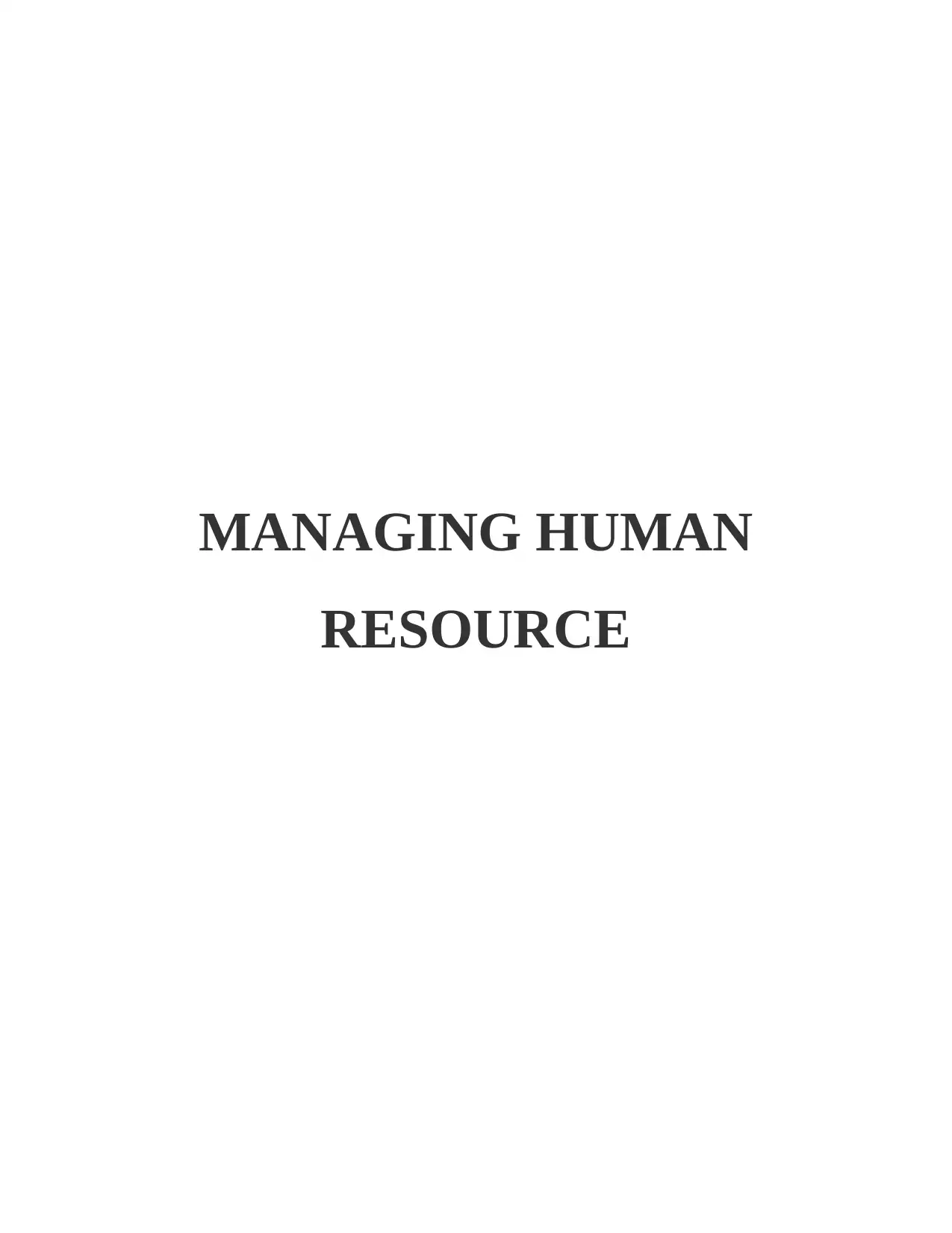
MANAGING HUMAN
RESOURCE
RESOURCE
Paraphrase This Document
Need a fresh take? Get an instant paraphrase of this document with our AI Paraphraser

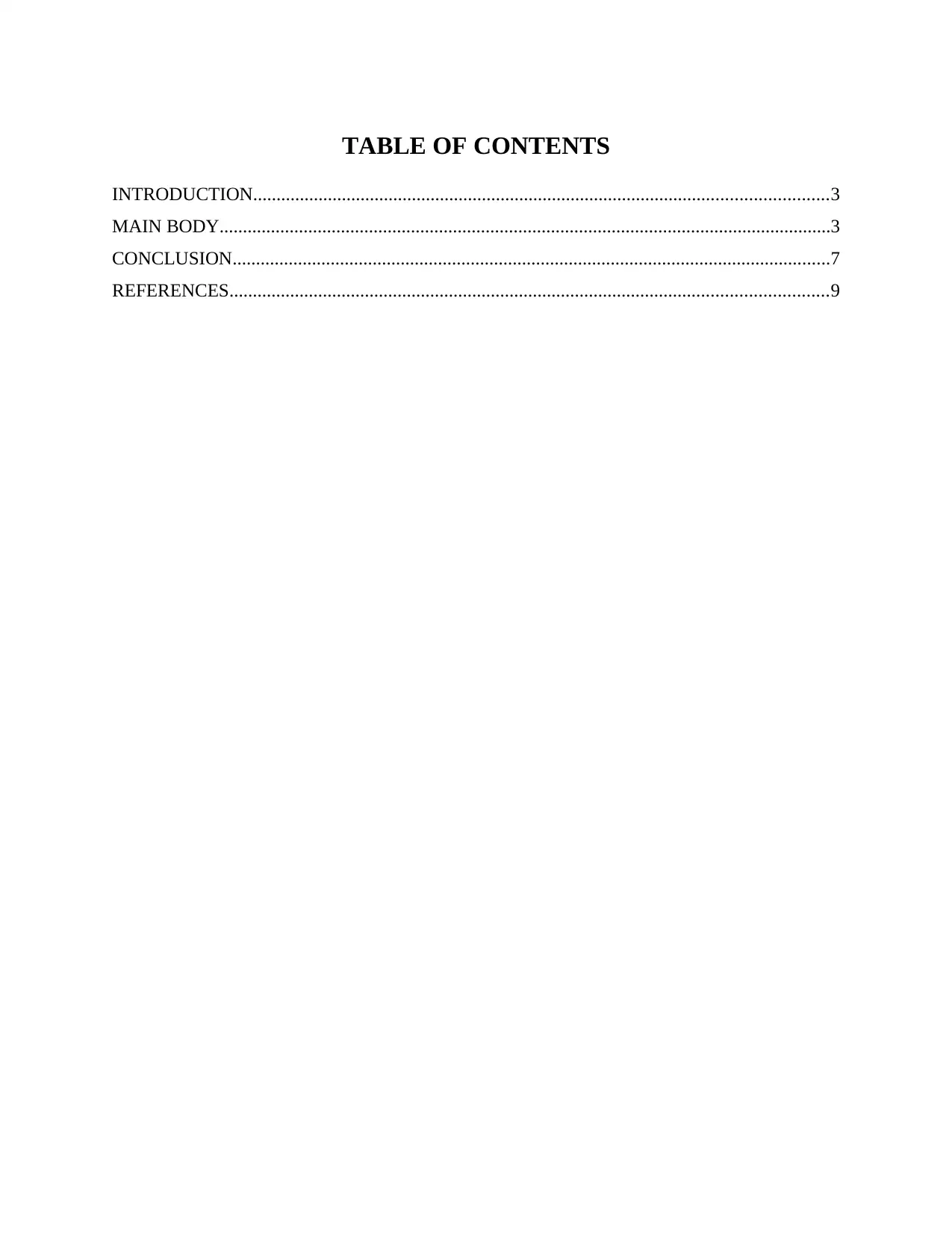
TABLE OF CONTENTS
INTRODUCTION...........................................................................................................................3
MAIN BODY...................................................................................................................................3
CONCLUSION................................................................................................................................7
REFERENCES................................................................................................................................9
INTRODUCTION...........................................................................................................................3
MAIN BODY...................................................................................................................................3
CONCLUSION................................................................................................................................7
REFERENCES................................................................................................................................9
⊘ This is a preview!⊘
Do you want full access?
Subscribe today to unlock all pages.

Trusted by 1+ million students worldwide
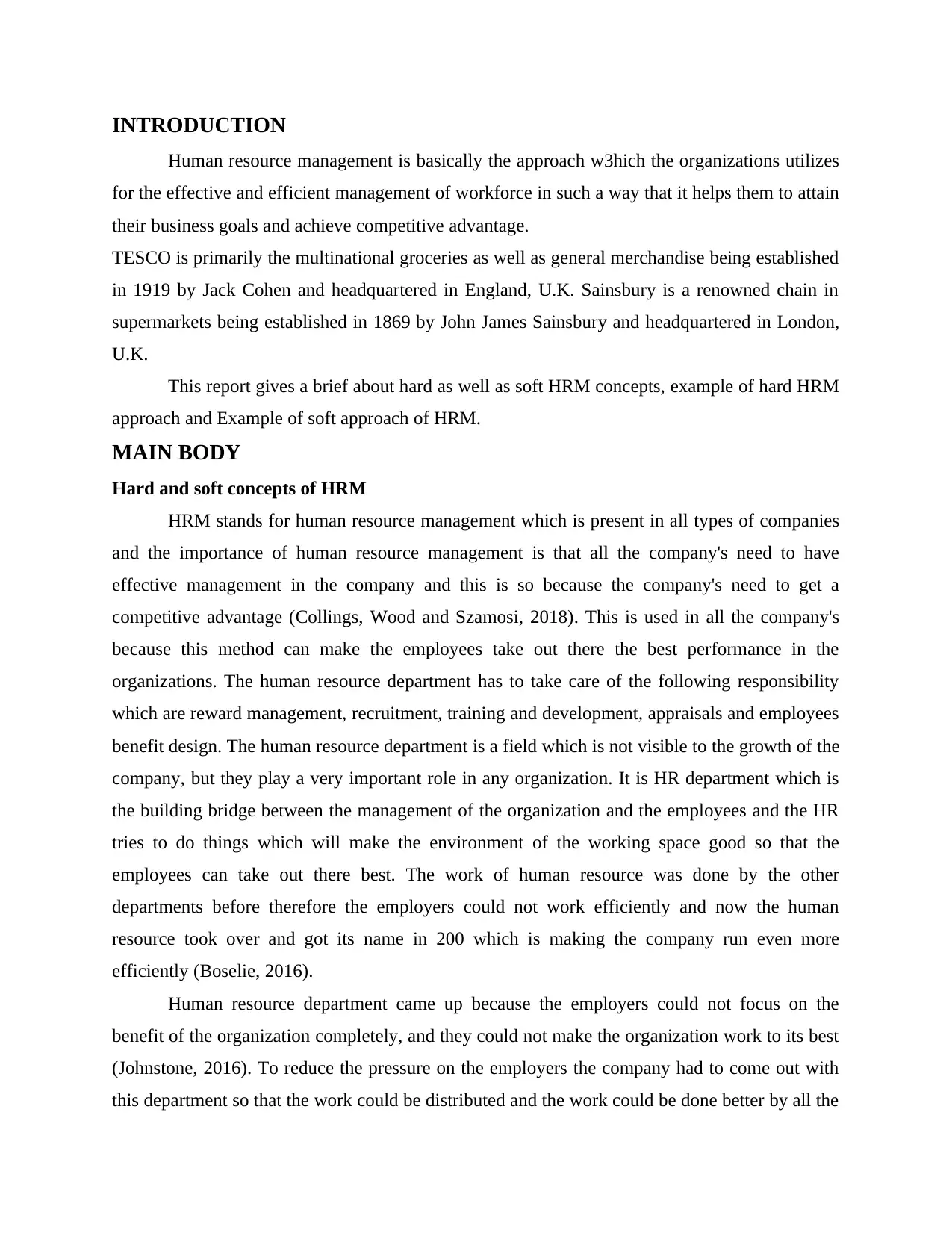
INTRODUCTION
Human resource management is basically the approach w3hich the organizations utilizes
for the effective and efficient management of workforce in such a way that it helps them to attain
their business goals and achieve competitive advantage.
TESCO is primarily the multinational groceries as well as general merchandise being established
in 1919 by Jack Cohen and headquartered in England, U.K. Sainsbury is a renowned chain in
supermarkets being established in 1869 by John James Sainsbury and headquartered in London,
U.K.
This report gives a brief about hard as well as soft HRM concepts, example of hard HRM
approach and Example of soft approach of HRM.
MAIN BODY
Hard and soft concepts of HRM
HRM stands for human resource management which is present in all types of companies
and the importance of human resource management is that all the company's need to have
effective management in the company and this is so because the company's need to get a
competitive advantage (Collings, Wood and Szamosi, 2018). This is used in all the company's
because this method can make the employees take out there the best performance in the
organizations. The human resource department has to take care of the following responsibility
which are reward management, recruitment, training and development, appraisals and employees
benefit design. The human resource department is a field which is not visible to the growth of the
company, but they play a very important role in any organization. It is HR department which is
the building bridge between the management of the organization and the employees and the HR
tries to do things which will make the environment of the working space good so that the
employees can take out there best. The work of human resource was done by the other
departments before therefore the employers could not work efficiently and now the human
resource took over and got its name in 200 which is making the company run even more
efficiently (Boselie, 2016).
Human resource department came up because the employers could not focus on the
benefit of the organization completely, and they could not make the organization work to its best
(Johnstone, 2016). To reduce the pressure on the employers the company had to come out with
this department so that the work could be distributed and the work could be done better by all the
Human resource management is basically the approach w3hich the organizations utilizes
for the effective and efficient management of workforce in such a way that it helps them to attain
their business goals and achieve competitive advantage.
TESCO is primarily the multinational groceries as well as general merchandise being established
in 1919 by Jack Cohen and headquartered in England, U.K. Sainsbury is a renowned chain in
supermarkets being established in 1869 by John James Sainsbury and headquartered in London,
U.K.
This report gives a brief about hard as well as soft HRM concepts, example of hard HRM
approach and Example of soft approach of HRM.
MAIN BODY
Hard and soft concepts of HRM
HRM stands for human resource management which is present in all types of companies
and the importance of human resource management is that all the company's need to have
effective management in the company and this is so because the company's need to get a
competitive advantage (Collings, Wood and Szamosi, 2018). This is used in all the company's
because this method can make the employees take out there the best performance in the
organizations. The human resource department has to take care of the following responsibility
which are reward management, recruitment, training and development, appraisals and employees
benefit design. The human resource department is a field which is not visible to the growth of the
company, but they play a very important role in any organization. It is HR department which is
the building bridge between the management of the organization and the employees and the HR
tries to do things which will make the environment of the working space good so that the
employees can take out there best. The work of human resource was done by the other
departments before therefore the employers could not work efficiently and now the human
resource took over and got its name in 200 which is making the company run even more
efficiently (Boselie, 2016).
Human resource department came up because the employers could not focus on the
benefit of the organization completely, and they could not make the organization work to its best
(Johnstone, 2016). To reduce the pressure on the employers the company had to come out with
this department so that the work could be distributed and the work could be done better by all the
Paraphrase This Document
Need a fresh take? Get an instant paraphrase of this document with our AI Paraphraser
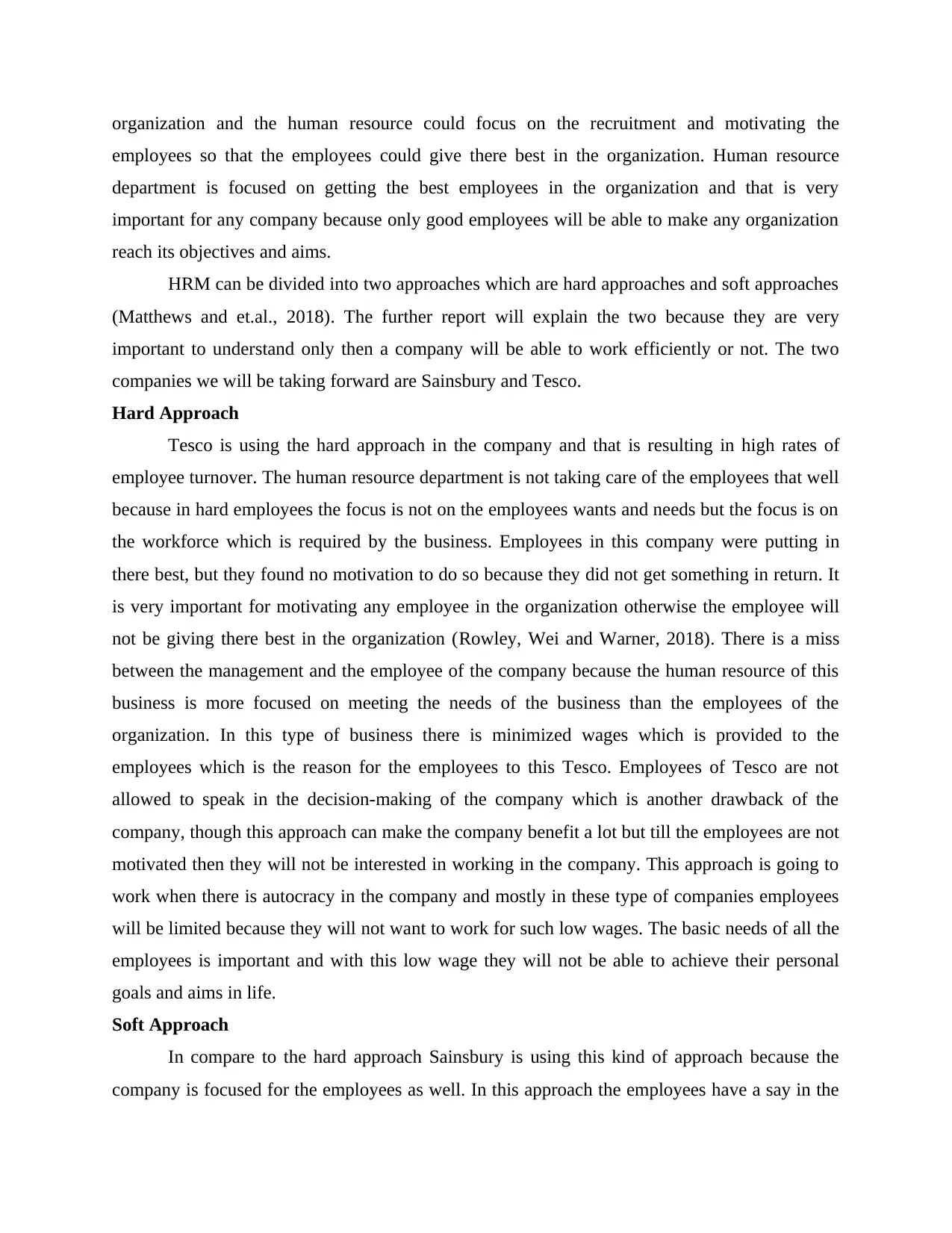
organization and the human resource could focus on the recruitment and motivating the
employees so that the employees could give there best in the organization. Human resource
department is focused on getting the best employees in the organization and that is very
important for any company because only good employees will be able to make any organization
reach its objectives and aims.
HRM can be divided into two approaches which are hard approaches and soft approaches
(Matthews and et.al., 2018). The further report will explain the two because they are very
important to understand only then a company will be able to work efficiently or not. The two
companies we will be taking forward are Sainsbury and Tesco.
Hard Approach
Tesco is using the hard approach in the company and that is resulting in high rates of
employee turnover. The human resource department is not taking care of the employees that well
because in hard employees the focus is not on the employees wants and needs but the focus is on
the workforce which is required by the business. Employees in this company were putting in
there best, but they found no motivation to do so because they did not get something in return. It
is very important for motivating any employee in the organization otherwise the employee will
not be giving there best in the organization (Rowley, Wei and Warner, 2018). There is a miss
between the management and the employee of the company because the human resource of this
business is more focused on meeting the needs of the business than the employees of the
organization. In this type of business there is minimized wages which is provided to the
employees which is the reason for the employees to this Tesco. Employees of Tesco are not
allowed to speak in the decision-making of the company which is another drawback of the
company, though this approach can make the company benefit a lot but till the employees are not
motivated then they will not be interested in working in the company. This approach is going to
work when there is autocracy in the company and mostly in these type of companies employees
will be limited because they will not want to work for such low wages. The basic needs of all the
employees is important and with this low wage they will not be able to achieve their personal
goals and aims in life.
Soft Approach
In compare to the hard approach Sainsbury is using this kind of approach because the
company is focused for the employees as well. In this approach the employees have a say in the
employees so that the employees could give there best in the organization. Human resource
department is focused on getting the best employees in the organization and that is very
important for any company because only good employees will be able to make any organization
reach its objectives and aims.
HRM can be divided into two approaches which are hard approaches and soft approaches
(Matthews and et.al., 2018). The further report will explain the two because they are very
important to understand only then a company will be able to work efficiently or not. The two
companies we will be taking forward are Sainsbury and Tesco.
Hard Approach
Tesco is using the hard approach in the company and that is resulting in high rates of
employee turnover. The human resource department is not taking care of the employees that well
because in hard employees the focus is not on the employees wants and needs but the focus is on
the workforce which is required by the business. Employees in this company were putting in
there best, but they found no motivation to do so because they did not get something in return. It
is very important for motivating any employee in the organization otherwise the employee will
not be giving there best in the organization (Rowley, Wei and Warner, 2018). There is a miss
between the management and the employee of the company because the human resource of this
business is more focused on meeting the needs of the business than the employees of the
organization. In this type of business there is minimized wages which is provided to the
employees which is the reason for the employees to this Tesco. Employees of Tesco are not
allowed to speak in the decision-making of the company which is another drawback of the
company, though this approach can make the company benefit a lot but till the employees are not
motivated then they will not be interested in working in the company. This approach is going to
work when there is autocracy in the company and mostly in these type of companies employees
will be limited because they will not want to work for such low wages. The basic needs of all the
employees is important and with this low wage they will not be able to achieve their personal
goals and aims in life.
Soft Approach
In compare to the hard approach Sainsbury is using this kind of approach because the
company is focused for the employees as well. In this approach the employees have a say in the
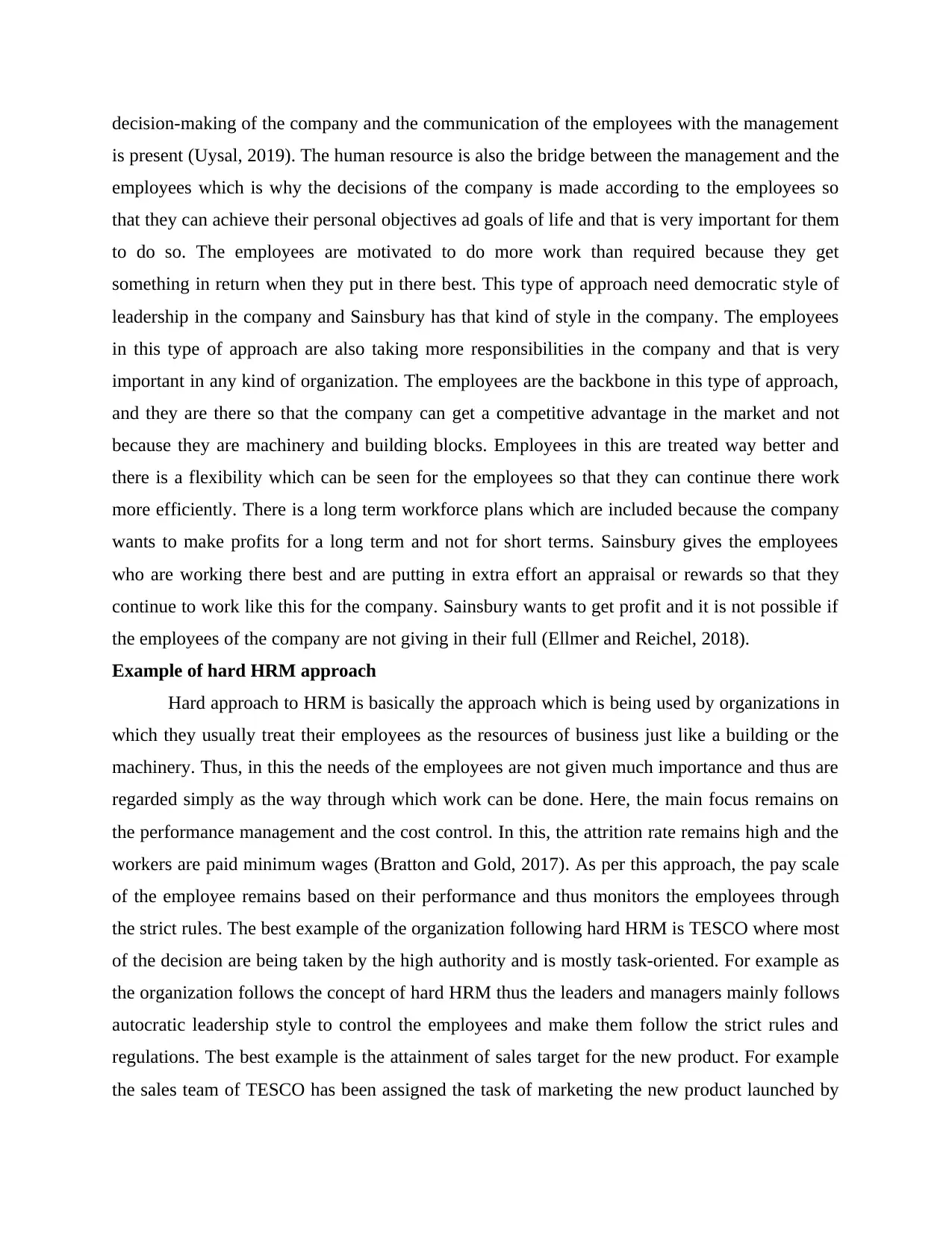
decision-making of the company and the communication of the employees with the management
is present (Uysal, 2019). The human resource is also the bridge between the management and the
employees which is why the decisions of the company is made according to the employees so
that they can achieve their personal objectives ad goals of life and that is very important for them
to do so. The employees are motivated to do more work than required because they get
something in return when they put in there best. This type of approach need democratic style of
leadership in the company and Sainsbury has that kind of style in the company. The employees
in this type of approach are also taking more responsibilities in the company and that is very
important in any kind of organization. The employees are the backbone in this type of approach,
and they are there so that the company can get a competitive advantage in the market and not
because they are machinery and building blocks. Employees in this are treated way better and
there is a flexibility which can be seen for the employees so that they can continue there work
more efficiently. There is a long term workforce plans which are included because the company
wants to make profits for a long term and not for short terms. Sainsbury gives the employees
who are working there best and are putting in extra effort an appraisal or rewards so that they
continue to work like this for the company. Sainsbury wants to get profit and it is not possible if
the employees of the company are not giving in their full (Ellmer and Reichel, 2018).
Example of hard HRM approach
Hard approach to HRM is basically the approach which is being used by organizations in
which they usually treat their employees as the resources of business just like a building or the
machinery. Thus, in this the needs of the employees are not given much importance and thus are
regarded simply as the way through which work can be done. Here, the main focus remains on
the performance management and the cost control. In this, the attrition rate remains high and the
workers are paid minimum wages (Bratton and Gold, 2017). As per this approach, the pay scale
of the employee remains based on their performance and thus monitors the employees through
the strict rules. The best example of the organization following hard HRM is TESCO where most
of the decision are being taken by the high authority and is mostly task-oriented. For example as
the organization follows the concept of hard HRM thus the leaders and managers mainly follows
autocratic leadership style to control the employees and make them follow the strict rules and
regulations. The best example is the attainment of sales target for the new product. For example
the sales team of TESCO has been assigned the task of marketing the new product launched by
is present (Uysal, 2019). The human resource is also the bridge between the management and the
employees which is why the decisions of the company is made according to the employees so
that they can achieve their personal objectives ad goals of life and that is very important for them
to do so. The employees are motivated to do more work than required because they get
something in return when they put in there best. This type of approach need democratic style of
leadership in the company and Sainsbury has that kind of style in the company. The employees
in this type of approach are also taking more responsibilities in the company and that is very
important in any kind of organization. The employees are the backbone in this type of approach,
and they are there so that the company can get a competitive advantage in the market and not
because they are machinery and building blocks. Employees in this are treated way better and
there is a flexibility which can be seen for the employees so that they can continue there work
more efficiently. There is a long term workforce plans which are included because the company
wants to make profits for a long term and not for short terms. Sainsbury gives the employees
who are working there best and are putting in extra effort an appraisal or rewards so that they
continue to work like this for the company. Sainsbury wants to get profit and it is not possible if
the employees of the company are not giving in their full (Ellmer and Reichel, 2018).
Example of hard HRM approach
Hard approach to HRM is basically the approach which is being used by organizations in
which they usually treat their employees as the resources of business just like a building or the
machinery. Thus, in this the needs of the employees are not given much importance and thus are
regarded simply as the way through which work can be done. Here, the main focus remains on
the performance management and the cost control. In this, the attrition rate remains high and the
workers are paid minimum wages (Bratton and Gold, 2017). As per this approach, the pay scale
of the employee remains based on their performance and thus monitors the employees through
the strict rules. The best example of the organization following hard HRM is TESCO where most
of the decision are being taken by the high authority and is mostly task-oriented. For example as
the organization follows the concept of hard HRM thus the leaders and managers mainly follows
autocratic leadership style to control the employees and make them follow the strict rules and
regulations. The best example is the attainment of sales target for the new product. For example
the sales team of TESCO has been assigned the task of marketing the new product launched by
⊘ This is a preview!⊘
Do you want full access?
Subscribe today to unlock all pages.

Trusted by 1+ million students worldwide
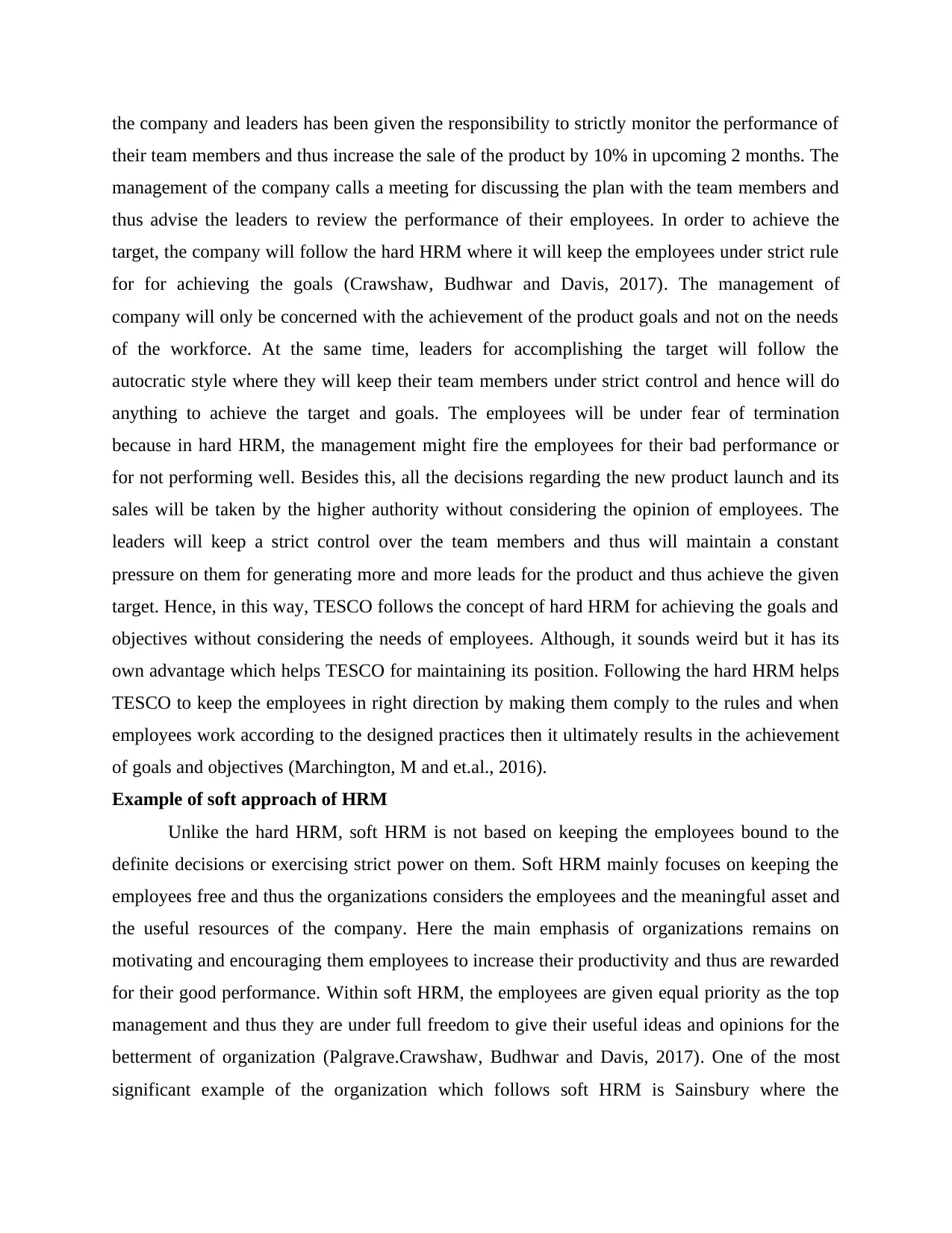
the company and leaders has been given the responsibility to strictly monitor the performance of
their team members and thus increase the sale of the product by 10% in upcoming 2 months. The
management of the company calls a meeting for discussing the plan with the team members and
thus advise the leaders to review the performance of their employees. In order to achieve the
target, the company will follow the hard HRM where it will keep the employees under strict rule
for for achieving the goals (Crawshaw, Budhwar and Davis, 2017). The management of
company will only be concerned with the achievement of the product goals and not on the needs
of the workforce. At the same time, leaders for accomplishing the target will follow the
autocratic style where they will keep their team members under strict control and hence will do
anything to achieve the target and goals. The employees will be under fear of termination
because in hard HRM, the management might fire the employees for their bad performance or
for not performing well. Besides this, all the decisions regarding the new product launch and its
sales will be taken by the higher authority without considering the opinion of employees. The
leaders will keep a strict control over the team members and thus will maintain a constant
pressure on them for generating more and more leads for the product and thus achieve the given
target. Hence, in this way, TESCO follows the concept of hard HRM for achieving the goals and
objectives without considering the needs of employees. Although, it sounds weird but it has its
own advantage which helps TESCO for maintaining its position. Following the hard HRM helps
TESCO to keep the employees in right direction by making them comply to the rules and when
employees work according to the designed practices then it ultimately results in the achievement
of goals and objectives (Marchington, M and et.al., 2016).
Example of soft approach of HRM
Unlike the hard HRM, soft HRM is not based on keeping the employees bound to the
definite decisions or exercising strict power on them. Soft HRM mainly focuses on keeping the
employees free and thus the organizations considers the employees and the meaningful asset and
the useful resources of the company. Here the main emphasis of organizations remains on
motivating and encouraging them employees to increase their productivity and thus are rewarded
for their good performance. Within soft HRM, the employees are given equal priority as the top
management and thus they are under full freedom to give their useful ideas and opinions for the
betterment of organization (Palgrave.Crawshaw, Budhwar and Davis, 2017). One of the most
significant example of the organization which follows soft HRM is Sainsbury where the
their team members and thus increase the sale of the product by 10% in upcoming 2 months. The
management of the company calls a meeting for discussing the plan with the team members and
thus advise the leaders to review the performance of their employees. In order to achieve the
target, the company will follow the hard HRM where it will keep the employees under strict rule
for for achieving the goals (Crawshaw, Budhwar and Davis, 2017). The management of
company will only be concerned with the achievement of the product goals and not on the needs
of the workforce. At the same time, leaders for accomplishing the target will follow the
autocratic style where they will keep their team members under strict control and hence will do
anything to achieve the target and goals. The employees will be under fear of termination
because in hard HRM, the management might fire the employees for their bad performance or
for not performing well. Besides this, all the decisions regarding the new product launch and its
sales will be taken by the higher authority without considering the opinion of employees. The
leaders will keep a strict control over the team members and thus will maintain a constant
pressure on them for generating more and more leads for the product and thus achieve the given
target. Hence, in this way, TESCO follows the concept of hard HRM for achieving the goals and
objectives without considering the needs of employees. Although, it sounds weird but it has its
own advantage which helps TESCO for maintaining its position. Following the hard HRM helps
TESCO to keep the employees in right direction by making them comply to the rules and when
employees work according to the designed practices then it ultimately results in the achievement
of goals and objectives (Marchington, M and et.al., 2016).
Example of soft approach of HRM
Unlike the hard HRM, soft HRM is not based on keeping the employees bound to the
definite decisions or exercising strict power on them. Soft HRM mainly focuses on keeping the
employees free and thus the organizations considers the employees and the meaningful asset and
the useful resources of the company. Here the main emphasis of organizations remains on
motivating and encouraging them employees to increase their productivity and thus are rewarded
for their good performance. Within soft HRM, the employees are given equal priority as the top
management and thus they are under full freedom to give their useful ideas and opinions for the
betterment of organization (Palgrave.Crawshaw, Budhwar and Davis, 2017). One of the most
significant example of the organization which follows soft HRM is Sainsbury where the
Paraphrase This Document
Need a fresh take? Get an instant paraphrase of this document with our AI Paraphraser
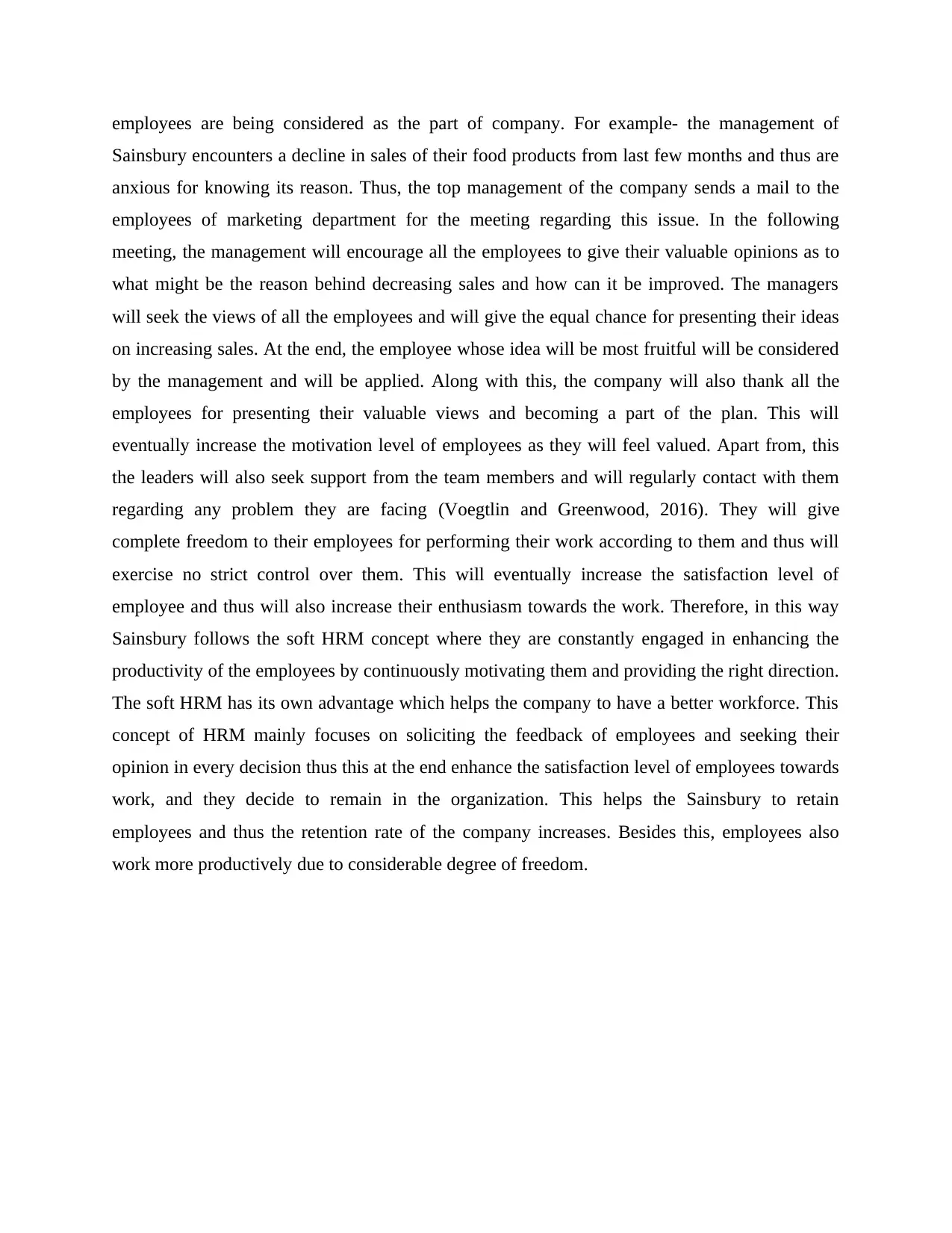
employees are being considered as the part of company. For example- the management of
Sainsbury encounters a decline in sales of their food products from last few months and thus are
anxious for knowing its reason. Thus, the top management of the company sends a mail to the
employees of marketing department for the meeting regarding this issue. In the following
meeting, the management will encourage all the employees to give their valuable opinions as to
what might be the reason behind decreasing sales and how can it be improved. The managers
will seek the views of all the employees and will give the equal chance for presenting their ideas
on increasing sales. At the end, the employee whose idea will be most fruitful will be considered
by the management and will be applied. Along with this, the company will also thank all the
employees for presenting their valuable views and becoming a part of the plan. This will
eventually increase the motivation level of employees as they will feel valued. Apart from, this
the leaders will also seek support from the team members and will regularly contact with them
regarding any problem they are facing (Voegtlin and Greenwood, 2016). They will give
complete freedom to their employees for performing their work according to them and thus will
exercise no strict control over them. This will eventually increase the satisfaction level of
employee and thus will also increase their enthusiasm towards the work. Therefore, in this way
Sainsbury follows the soft HRM concept where they are constantly engaged in enhancing the
productivity of the employees by continuously motivating them and providing the right direction.
The soft HRM has its own advantage which helps the company to have a better workforce. This
concept of HRM mainly focuses on soliciting the feedback of employees and seeking their
opinion in every decision thus this at the end enhance the satisfaction level of employees towards
work, and they decide to remain in the organization. This helps the Sainsbury to retain
employees and thus the retention rate of the company increases. Besides this, employees also
work more productively due to considerable degree of freedom.
Sainsbury encounters a decline in sales of their food products from last few months and thus are
anxious for knowing its reason. Thus, the top management of the company sends a mail to the
employees of marketing department for the meeting regarding this issue. In the following
meeting, the management will encourage all the employees to give their valuable opinions as to
what might be the reason behind decreasing sales and how can it be improved. The managers
will seek the views of all the employees and will give the equal chance for presenting their ideas
on increasing sales. At the end, the employee whose idea will be most fruitful will be considered
by the management and will be applied. Along with this, the company will also thank all the
employees for presenting their valuable views and becoming a part of the plan. This will
eventually increase the motivation level of employees as they will feel valued. Apart from, this
the leaders will also seek support from the team members and will regularly contact with them
regarding any problem they are facing (Voegtlin and Greenwood, 2016). They will give
complete freedom to their employees for performing their work according to them and thus will
exercise no strict control over them. This will eventually increase the satisfaction level of
employee and thus will also increase their enthusiasm towards the work. Therefore, in this way
Sainsbury follows the soft HRM concept where they are constantly engaged in enhancing the
productivity of the employees by continuously motivating them and providing the right direction.
The soft HRM has its own advantage which helps the company to have a better workforce. This
concept of HRM mainly focuses on soliciting the feedback of employees and seeking their
opinion in every decision thus this at the end enhance the satisfaction level of employees towards
work, and they decide to remain in the organization. This helps the Sainsbury to retain
employees and thus the retention rate of the company increases. Besides this, employees also
work more productively due to considerable degree of freedom.
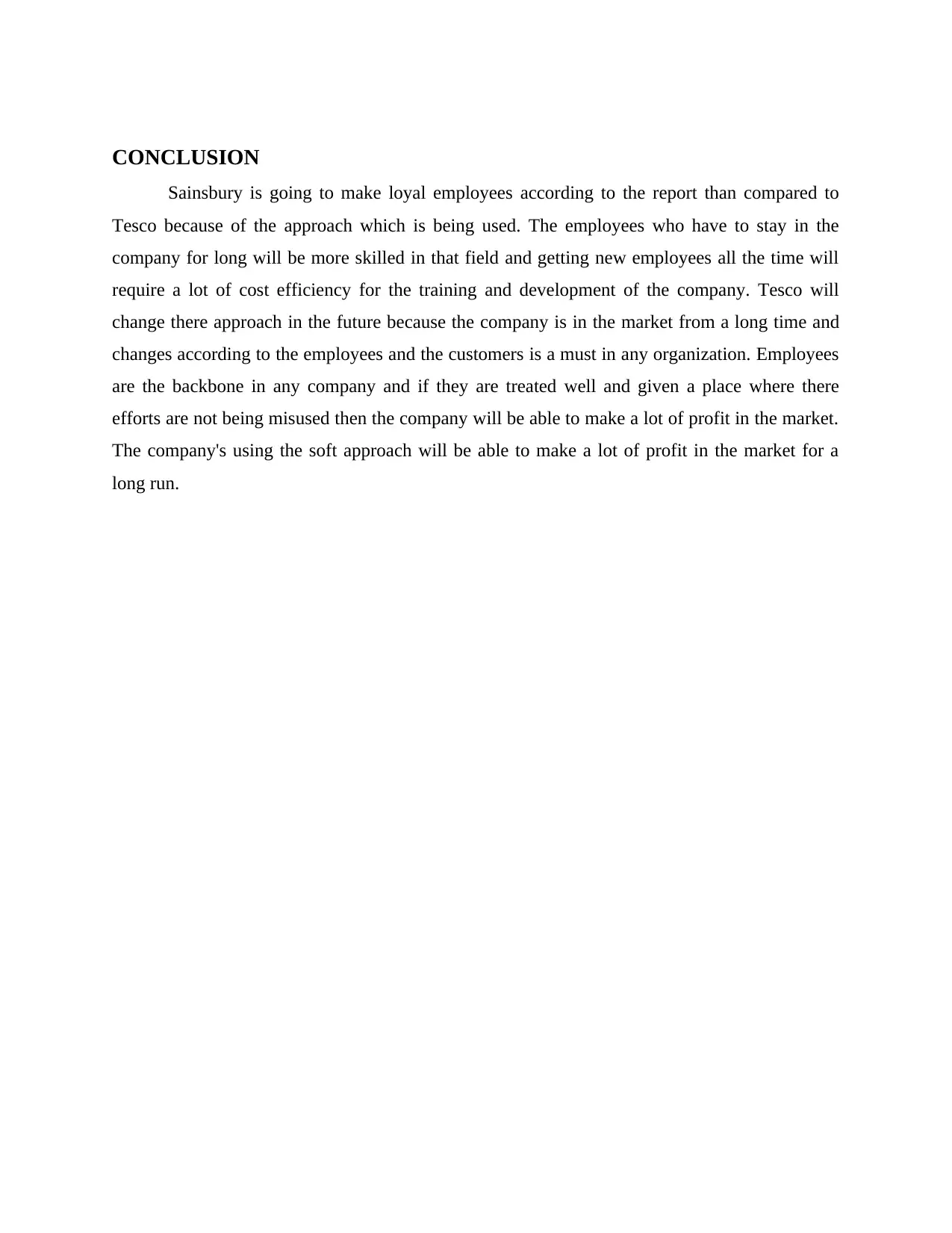
CONCLUSION
Sainsbury is going to make loyal employees according to the report than compared to
Tesco because of the approach which is being used. The employees who have to stay in the
company for long will be more skilled in that field and getting new employees all the time will
require a lot of cost efficiency for the training and development of the company. Tesco will
change there approach in the future because the company is in the market from a long time and
changes according to the employees and the customers is a must in any organization. Employees
are the backbone in any company and if they are treated well and given a place where there
efforts are not being misused then the company will be able to make a lot of profit in the market.
The company's using the soft approach will be able to make a lot of profit in the market for a
long run.
Sainsbury is going to make loyal employees according to the report than compared to
Tesco because of the approach which is being used. The employees who have to stay in the
company for long will be more skilled in that field and getting new employees all the time will
require a lot of cost efficiency for the training and development of the company. Tesco will
change there approach in the future because the company is in the market from a long time and
changes according to the employees and the customers is a must in any organization. Employees
are the backbone in any company and if they are treated well and given a place where there
efforts are not being misused then the company will be able to make a lot of profit in the market.
The company's using the soft approach will be able to make a lot of profit in the market for a
long run.
⊘ This is a preview!⊘
Do you want full access?
Subscribe today to unlock all pages.

Trusted by 1+ million students worldwide
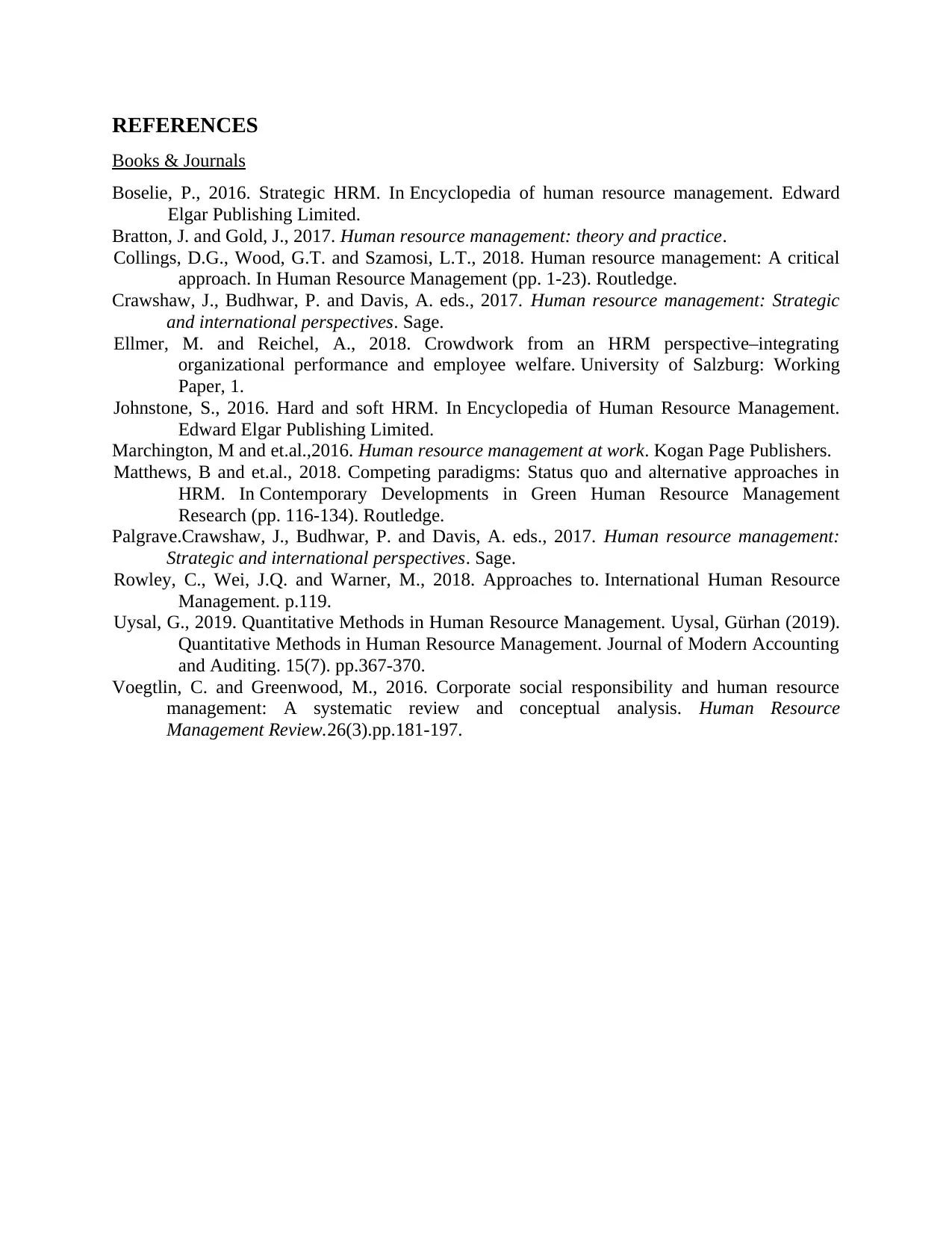
REFERENCES
Books & Journals
Boselie, P., 2016. Strategic HRM. In Encyclopedia of human resource management. Edward
Elgar Publishing Limited.
Bratton, J. and Gold, J., 2017. Human resource management: theory and practice.
Collings, D.G., Wood, G.T. and Szamosi, L.T., 2018. Human resource management: A critical
approach. In Human Resource Management (pp. 1-23). Routledge.
Crawshaw, J., Budhwar, P. and Davis, A. eds., 2017. Human resource management: Strategic
and international perspectives. Sage.
Ellmer, M. and Reichel, A., 2018. Crowdwork from an HRM perspective–integrating
organizational performance and employee welfare. University of Salzburg: Working
Paper, 1.
Johnstone, S., 2016. Hard and soft HRM. In Encyclopedia of Human Resource Management.
Edward Elgar Publishing Limited.
Marchington, M and et.al.,2016. Human resource management at work. Kogan Page Publishers.
Matthews, B and et.al., 2018. Competing paradigms: Status quo and alternative approaches in
HRM. In Contemporary Developments in Green Human Resource Management
Research (pp. 116-134). Routledge.
Palgrave.Crawshaw, J., Budhwar, P. and Davis, A. eds., 2017. Human resource management:
Strategic and international perspectives. Sage.
Rowley, C., Wei, J.Q. and Warner, M., 2018. Approaches to. International Human Resource
Management. p.119.
Uysal, G., 2019. Quantitative Methods in Human Resource Management. Uysal, Gürhan (2019).
Quantitative Methods in Human Resource Management. Journal of Modern Accounting
and Auditing. 15(7). pp.367-370.
Voegtlin, C. and Greenwood, M., 2016. Corporate social responsibility and human resource
management: A systematic review and conceptual analysis. Human Resource
Management Review.26(3).pp.181-197.
Books & Journals
Boselie, P., 2016. Strategic HRM. In Encyclopedia of human resource management. Edward
Elgar Publishing Limited.
Bratton, J. and Gold, J., 2017. Human resource management: theory and practice.
Collings, D.G., Wood, G.T. and Szamosi, L.T., 2018. Human resource management: A critical
approach. In Human Resource Management (pp. 1-23). Routledge.
Crawshaw, J., Budhwar, P. and Davis, A. eds., 2017. Human resource management: Strategic
and international perspectives. Sage.
Ellmer, M. and Reichel, A., 2018. Crowdwork from an HRM perspective–integrating
organizational performance and employee welfare. University of Salzburg: Working
Paper, 1.
Johnstone, S., 2016. Hard and soft HRM. In Encyclopedia of Human Resource Management.
Edward Elgar Publishing Limited.
Marchington, M and et.al.,2016. Human resource management at work. Kogan Page Publishers.
Matthews, B and et.al., 2018. Competing paradigms: Status quo and alternative approaches in
HRM. In Contemporary Developments in Green Human Resource Management
Research (pp. 116-134). Routledge.
Palgrave.Crawshaw, J., Budhwar, P. and Davis, A. eds., 2017. Human resource management:
Strategic and international perspectives. Sage.
Rowley, C., Wei, J.Q. and Warner, M., 2018. Approaches to. International Human Resource
Management. p.119.
Uysal, G., 2019. Quantitative Methods in Human Resource Management. Uysal, Gürhan (2019).
Quantitative Methods in Human Resource Management. Journal of Modern Accounting
and Auditing. 15(7). pp.367-370.
Voegtlin, C. and Greenwood, M., 2016. Corporate social responsibility and human resource
management: A systematic review and conceptual analysis. Human Resource
Management Review.26(3).pp.181-197.
1 out of 10
Related Documents
Your All-in-One AI-Powered Toolkit for Academic Success.
+13062052269
info@desklib.com
Available 24*7 on WhatsApp / Email
![[object Object]](/_next/static/media/star-bottom.7253800d.svg)
Unlock your academic potential
Copyright © 2020–2025 A2Z Services. All Rights Reserved. Developed and managed by ZUCOL.





